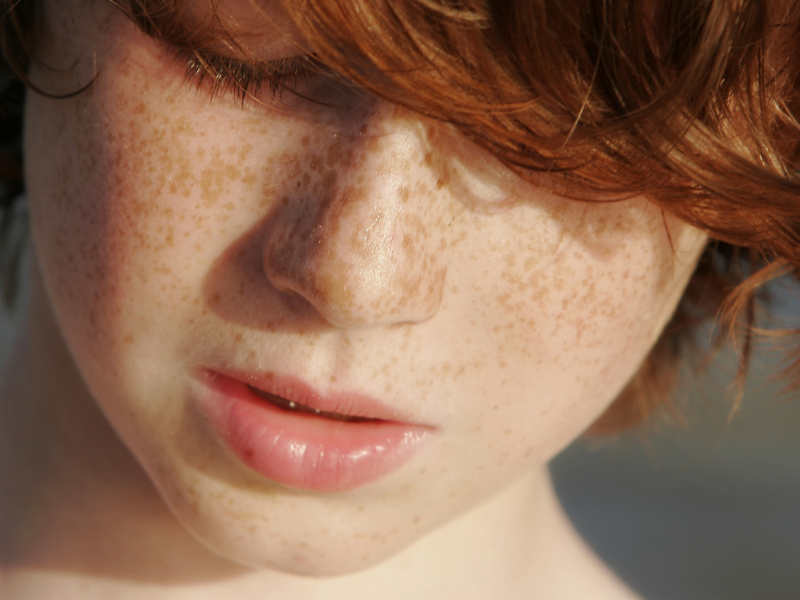Main Image: © ParkerDeen from Getty Images Signature via Canva.com
Freckles, like red hair, are a unique feature to have. For decades, people viewed freckles as “bad” or “ugly”, but they’re now sought after and known to be very special. Freckles are actually a dominant trait, which means lots of people have them, but redheads usually have more or they appear darker than on those without red hair.
The presence of freckles in redheads is mainly due to genetic factors. People with red hair typically have a higher concentration of the pigment called pheomelanin in their skin. Pheomelanin is responsible for the red hair color and also contributes to the formation of freckles when exposed to sunlight. Freckles are small concentrations of melanin that appear as spots on the skin when melanin is unevenly distributed. The combination of fair skin, increased pheomelanin, and exposure to sunlight leads to freckles being more common in individuals with red hair.
Freckles are considered unique because they are a form of skin pigmentation that varies from person to person. Each person’s freckles are a result of their individual genetic makeup and how their skin responds to sunlight. Due to the combination of genetic factors and the impact of environmental elements like sunlight, freckles create a unique and individualized appearance for each person. This uniqueness contributes to the diversity and beauty of human skin.
Freckles aren’t sun damage or a sign of skin cancer, but they do need protection to stay beautiful and thriving. Some people get more freckles in the summertime or their freckles become more noticeable, but if you have freckles year-round, they aren’t going anywhere. Instead, the main focus is to keep the skin healthy and keep your freckles defined and not muddy. Here’s how you can protect your freckles this summer:
1. Always wear sunscreen
We know this is a no brainer, but the “muddy” look of freckles actually comes from age spots, sun spots, and other skin discoloration happening around the freckles. You can achieve this by always wearing sunscreen and using proper sun protection. Make sure you wear SPF year-round and reapply every 1-2 hours as needed.
2. Know what are freckles and what are not
Another important aspect of keeping freckles healthy is knowing what are freckles and what aren’t. Our body can create cancerous spots and moles that look similar to freckles but are dangerous. Freckles themselves are not a sign of skin cancer, but they can indicate a heightened sensitivity to sunlight. Freckles are small concentrations of melanin that appear on the skin due to uneven distribution of the pigment after sun exposure. They are more common in people with fair skin and those who are genetically predisposed to produce more melanin in response to sunlight.
While freckles themselves are generally harmless, they can be an indication that your skin is more susceptible to sun damage. Prolonged and excessive sun exposure can lead to various forms of skin damage, including sunburn, premature aging, and an increased risk of developing skin cancer, especially in individuals with fair skin.
3. Protect in other ways
To protect your skin from potential sun damage, it’s essential to use sunscreen (as stated above), but go the extra mile to wear protective clothing, and limit sun exposure, especially during peak hours when the sun’s rays are strongest.
4. Go to the dermatologist
If you notice any changes in your freckles or any concerning spots on your skin, it’s crucial to consult a dermatologist for a proper evaluation. They can determine whether any abnormalities need further investigation to rule out skin cancer. Early detection is key in managing and treating skin-related issues.
5. Take care of the skin with a consistent skin routine
Of course, like the rest of our skin, our freckles need care. Exfoliating, using hydrating products, and keeping the skin bright with things like Vitamin C will all make your freckles look healthier and more beautiful. And, don’t forget to keep your skin moisturized to maintain its health and minimize dryness, which can exacerbate skin issues.
6. Seek shade
Whenever possible, stay in the shade, especially during peak sunlight hours when the sun’s rays are the strongest.
7. Avoid tanning
Avoid tanning beds and sunbathing, as they can cause further damage to your skin.
8. Skin hydration
Drink plenty of water to keep your skin hydrated from the inside out.
Remember, freckles themselves are harmless, but protecting your skin from sun damage is crucial to maintain healthy skin and minimize the risk of developing other skin issues, including skin cancer. If you have any concerns about your skin or freckles, consult a dermatologist for personalized advice and recommendations.
Rock it like a Redhead!
RELATED POSTS
READ: Freckles & Moles: This Is When Redheads Should Get Checked By A Dermatologist
READ: How Redheads Can Apply Foundation Without Covering Freckles



